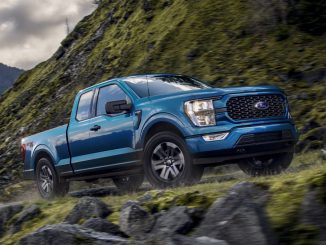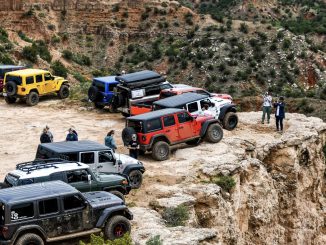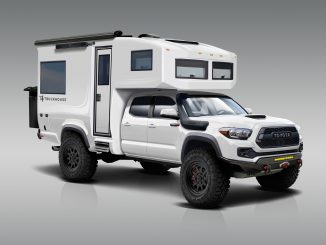
The hard-side versus the pop-up. Which truck camper is better? When it comes to RVs, everyone knows that the truck camper is superior when it comes to boondocking, off-road prowess, and the ability to get to remote campsites. Yet, there are some key differences between the hard-side and the pop-up truck camper that must be considered before purchase. In many respects, the hard-side is better than the pop-up and visa versa. That’s the purpose of this article. In it, we will examine the strengths and weakness of each type of camper so that you, the consumer, can make a better, informed decision before buying.
So which type of truck camper is better? That’s a great question and one that has been debated for years. Years ago we were ask to write an article on this hotly contested topic. Having owned only hard-side campers before, however, we never wrote one because we didn’t think we were qualified to do so. How could we honestly compare and contrast the two types of campers without having owned a pop-up? All of that changed with the recent purchase of a Four Wheel Pop-Up Camper Grandby. Now that we have driven and camped in both types of campers, we can honestly give our opinions about the pros and cons of each.
Of course, when it comes to buying a camper, it really comes down to personal preference. Not everyone wants to travel and camp in a large, palatial, triple-slide truck camper. Some are content to travel small and light, while others want to go big and heavy. What kind of roads and places do you intend on exploring in your camper? What time of year will you’ll be using it? Will you be towing a “toad” or a trailer of some kind? Like everything in life, it really comes down to what’s important to you at this phase in your life. So without further adieu, let’s take a look at the pros and cons of the hard-side and the pop-up.

Hard-Side Truck Camper Pros
The hard-side truck camper offers a number of pros. The most obvious pros is the number of choices in today’s market. There are far more hard-side makes and models today compared to the pop-up and this includes used campers. At present, the big three—Lance, Northwood Manufacturing, and Host—offer a total of 24 full-size models. Some hard-side campers are made for full-size, short-bed trucks, while others are made for full-size, long-bed trucks. A good number of these campers offer one or more slide-outs as well, something you can’t get in a pop-up. Looking for luxurious accommodations away from home? It’s hard to beat the luxury of a hard-side, the best being the Host Mammoth 11.6 and the Rugged Mountain Denali 3S triple-slide campers. Both offer recliners, fireplaces, kitchen islands, massive battery banks, and more. As a matter of fact, the interiors of these campers are so luxurious and spacious, that it’s hard to believe you’re in a truck camper.


Which segues nicely into the next hard-side benefit—size. In general, hard-side campers are larger and offer much more living space than a pop-up truck camper. This is due not only to the longer floorplans—with some offering a floor length of 12 feet—but also to the one or more slide-outs which offer more living space as well. Indeed, the amount of living space found in the aforementioned Mammoth and Denali triple-slide campers rivals the amount living space found in a motorhome. Not only that, but the hard-wall design offers more storage and living space due to the higher walls and roof lockers. Which leads us to a huge benefit on a hard-side—the bed. The bed in a hard-side camper is always there and doesn’t require raising the roof to get into it. There’s nothing like stopping for lunch while on the road and taking a quick power nap before getting back on the road.

Looking for the more amenities? The hard-side truck camper is hard to beat. While it’s true that a good number of pop-ups offer a wet-bath with a bathroom and shower—most pop-ups are small and cramped—a good number of hard-side models offer much larger dry baths with large grey and black water holding tanks. Not only that, but hard-side campers, in general, offer larger holding tanks for boondocking with the aforementioned Rugged Mountain Denali 3S currently offering the largest at a whopping 82 gallons of fresh water. Yes, the Outfitter Apex and Juno pop-up models offer 44 gallons of fresh water—which is an amazing amount for a pop-up—but in general a pop-up can’t touch a hard-side when it comes to holding tank sizes. Looking for a heavy-duty air conditioner for summer? The hard-side truck camper offers more choices with both AC and DC air conditioner models installed at the factory.


Looking for a true four-season truck camper? In general, the hard-side is the way to go. Yes, a good number of hard-side models are three-season campers only with “exposed” holding tanks, yet almost any kind of hard-side truck camper can be purchased for four-season use. Four season campers offer not only higher R-value ceilings, roofs, floors and walls, but also “heated” holding tanks and water lines to prevent freezing and insulated dual-thermopane windows. The best four season campers are those made by Host, Overland Explorer Vehicles, Rugged Mountain, Northwood Manufacturing (Arctic Fox), nuCamp, and Lance. Of course, a fringe benefit of having a better insulated, hard-wall camper is that they are quieter and offer better protection from bears. As a matter of fact, some national parks won’t allow a pop-up in national parks where bears are prevalent.
So to recap, here are the pros of the hard-side truck camper:
- More makes and models of campers
- Larger floorplans and more living space (slide-outs)
- Larger holding tanks (boondock longer)
- More storage
- More air conditioner options
- Full-time bed
- Larger electrical systems (batteries and solar)
- Better facilities (toilet and shower)
- Better protection from bears
- Better insulated, quieter
Hard-Side Truck Camper Cons
As great as the hard-side truck camper is, there are a number of cons compared to a pop-up. Being the largest and heaviest of the two types of campers, the biggest negative of the hard-side is its size, which creates greater wind resistance on the road, and as a result, lower fuel economy. The two are inter-related, of course, but wind resistance needs to also be pointed out because it can be a literally be drag on the highway. If you’ve ever driven in high winds, you know what we mean. Few things are worse than a “white-knuckle” drive on an Interstate in high winds and passing semis. As for the lower fuel economy, be prepared for paying more at the pump if you go with a hard-side. The taller and heavier the camper, the worse your mileage will be. Keep that in mind when buying a camper.
Being heavier, the hard-side truck camper also needs a higher rated truck with more payload. We’ve written extensively about GVWR and payload here at Truck Camper Adventure, so we won’t go too deeply about this important subject here, but you will need a higher-rated truck to carry the heavier, hard-side campers in today’s market (the superb, lightweight hard-side campers made by Scout being the most notable exception to this general rule). As a matter of fact, a good portion of the single, double, and triple-slide truck campers being built today require a one-ton DRW truck for greater payload and stability. Some have even resorted to buying a higher-rated Class 4 truck like the Ford F-450 or a Class 5 truck like the Ram 5500 to haul the largest, most luxurious double and triple-slide campers being built today.

Which leads us to another important point regarding the hard-side camper’s size. While buying a camper with more living space can be huge bonus, the fact that the hard-side is generally larger also means the camper can be more difficult to store. If your property is large and flat, finding that space to store your rig won’t be a big concern, of course, but it can be for those who live in residential communities with strict HOA rules and the like. Keeping your camper out of the sun and weather is important to ensure its long life, too, and the easiest way to do this to keep it under cover. This means you’ll need to either buy a home with a RV garage or have a large RV carport or garage built on your property.
Lastly, you can’t discuss the cons of the hard-side camper without mentioning cost. In general, hard-side campers are more expensive than pop-ups, though some of the larger manufacturers like Lance and Northwood Manufacturing are able to keep costs down by building truck campers in volume. Unfortunately, inflation has put some hard-side models out of the reach of today’s consumer with some slide-out models exceeding $70,000 in cost, though a decent non-slide hard-side camper with smaller holding tanks can be purchased for around $40,000. Again, it comes down to what’s important to you and the size of your wallet.

So to recap, here are the cons of the hard-side truck camper:
- Poor fuel mileage
- Heavier (needs a higher rated truck)
- Greater wind resistance
- Fewer air conditioner options
- More expensive
- Harder to store (requires more space)
Pop-Up Truck Camper Pros
If you like exploring off-road, nothing beats a pop-up. Yes, a good 4WD truck makes off-road adventures possible, yet without an equally capable camper, you’re pretty limited on where you can go. What makes the pop-up camper a terrific option? It basically comes down to one thing—the camper’s low profile. This lower profile offers less wind resistance which results in better fuel economy and less pain at the fuel pump. Some owners are reporting 18 mpgs and in some cases even higher hauling a pop-up. The pop-up camper’s lower profile and lower center of gravity also means that it can be driven up gnarly forest service roads, under low hanging bridges, and under rock outcroppings that would stop a hard-side camper dead in its tracks. What’s the bottom line? There simply isn’t a more capable camper when it comes to extreme off-roading than a pop-up truck camper.

What are some additional benefits of the pop-up camper? The pop-up’s low weight and relatively low cost are two big ones. Depending on the size and method of construction, today’s pop-up weighs anywhere between 800 and 1,500 pounds. This means a pop-up camper can be hauled by lower-rated pickups like the mid-size Toyota Tacoma and the half-ton Ford F-150. Being smaller and lighter also means that today’s pop-up costs less than today’s hard-side, though it really depends on the manufacturing process and features. The final benefit, of course, is that the pop-up truck camper is easier to store. Unlike today’s hard-side camper, the pop-up can be stored in many residential garages with the top down, something that can’t be done in a hard-side.
While there are far more hard-side than pop-up campers on today’s roads, the number of pop-up camper choices is still impressive. There are nearly a dozen manufacturers producing slide-in pop-up campers today. The biggest manufacturers include industry juggernaut Four Wheel Campers which builds nine models; Phoenix Campers which offers five semi-custom models; and Overland Explorer Vehicles (OEV) which produces 10 hard-side and pop-up truck camper models including several chassis-mounted designs. BundutecUSA offers nine pop-up models but produces in lower numbers and with more customization than most. Some of our favorite pop-up designs include OEV’s superb Back Country 6.85, Outfitter’s elite Apex 8, the Supertramp Camper Flagship LT, and the BundutecUSA Wild. In order to capitalize on the popularity of the pop-up, our friends at Scout are even producing their own pop-up designs now.

So to recap, here the the pros of the pop-up truck camper:
- Lighter (can be hauled by lower-rated mid-size and full-size trucks)
- Better fuel mileage
- Easier to drive (less wind resistance)
- Better performance off-road (lower COG)
- Lower profile (can go where few RVs can)
- Cheaper (less cost)
- Easier to store at home/storage facility
Pop-Up Truck Camper Cons
So what are the cons of the pop-up truck camper? There aren’t many though they’re fairly significant. The biggest con is that the top needs to be raised in order to use the camper. As a result, roadside stops and campsite setup takes a little more time. These extra seconds need to be factored in for roadside nature calls, especially if raising the roof has to be done manually. The pop-up is less stealthy too. Everyone knows that when the top is up, somebody is home. The pop-up truck camper is generally smaller too, meaning less living space inside and fewer options for entertaining family and friends. You won’t find a large dry bath in a pop-up either, though a good number of pop-ups feature a decent wet-bath with a cassette toilet. Pop-ups also offer fewer options for air conditioning though the DC air conditioners are generally smaller and lighter, though they will need a sizable amount of batteries to run one—something most pop-ups lack since one or two 100 amp hour batteries is the norm.

The negatives associated with the soft walls of the pop-up need to be factored in as well. Lacking hard-walls, the pop-up truck camper offers fewer options when it comes to storage, though some manufacturers have found creative ways to offset this by offering a few roof lockers, under-bed storage, and storage in raised floors. If you enjoy winter camping, you’ll need to factor in the lower R-rating and how much propane or diesel you will need to keep warm, though many companies are now offering insulation kits for the soft walls that Velcro to the walls. Having soft-walls in your camper also means more noise—if you own a pop-up a good set of ear plugs are a must. We attended a Four Wheel Camper rally and was surprised at how well we could hear everything outside. And if you happen to camp in the rain, you’ll need to ensure that the top is properly aired out and dry. That will take extra time when you get home. Oh, and if your plans include visits to places where bears are prevalent, many campgrounds won’t allow you to camp in a pop-up. Something to keep in mind if your plans also involve hunting and fishing in bear country.
So to recap, here the the cons of the pop-up truck camper:
- Smaller (less living space)
- Need to raise top up to use (manual or automated)
- Less interior storage
- Smaller electrical systems (batteries and solar)
- Less stealthy
- Noisier inside when camping
- More prone to weather/temperatures
- Top needs to be aired out and dried after rain
- Fewer camping options in certain areas due to bears
Final Thoughts
The hard-side versus the pop-up. So which type of truck camper is better? Taking into account the pros and cons of each, it really comes down to what’s important to you and what kind of roads and places you intend on exploring. The truck, of course, plays a major role in what you choose. If you already own a truck, you’ll be limited on the truck’s payload rating and what the truck is able to haul. For example, a lower-rated pickup with a small gasoline V8 or a V6 means you might want to look seriously at a pop-up simply due to the fact that it’s lighter and offers less wind resistance on the road. On the other hand, if you already own a capable one-ton or higher-rated, long-bed truck, then you have a plethora of choices. Of course, if you’re having trouble choosing between either a hard-side or a pop-up, you can always buy one of each. That’s what we did and we haven’t looked back since. Like we always say, “what’s better than one camper? Two campers!”


















Good article, but I’m a dedicated Pop-Up guy with a Northstar 850SC. On the Pro Pop-Up side one important plus is never mentioned. With the top up I have a complete 360 view of my territory and if needed a complete 360 ventilation option. I love to see all around me out in the Boondocks and the hard sides I’ve looked at have only about 25% of the view I have! Scott
In the Pros/cons there are a couple more considerations you forgot .
First is refrigerator size. The pop up limits the amount of height available for a refrigerator so most popups top out around a 4cuft refrigerator while it isn’t unusual to find a 6cuft absorption or 8 cuft compressor refrigerator in a Hard Side. 2-4 cuft makes the difference between Beer OR Food vs Beer AND food in the refrigerator.
Second is oven types The additional top mounted storage in a hard side allows both a microwave/convection oven in addition to a propane oven while most pop ups only provide one or the other due to the space constrains. While many only care if they have one or the other it is nice to have the option for both that the hard side more often provides.
The wife and I have had everything between backpacks w/wo tents or tarps to big Class A motor homes throughout our 52 years together. It really does depend upon one’s desires at any particular time in life and budget. We have immensely enjoyed all of our “RVs” and currently have a twin slide Lance on a K3500 dually and a ’99 TJ toad. We realize and appreciate what we have (and have had) to not be afraid of change. Our desire is to keep going forward for as long as our health allows us and use whatever means necessary to do so.
I love that approach.
There are only four camper categories that matter.
1: Pooping outside Camper.
2: Pooping inside Camper, in full view of your wife with full smells.
3: Pooping inside Camper out of view but still with smells.
4: Pooping inside Camper out of view and nearly no smells.
All other categories are meaningless.
🤣👍
I owned a Northern Lite 8.11 for a number of years and am surprised you did not mention it when talking true four season hard side campers. They are truly the best in this category in my experience.
The camper got me off grid but not that far off grid. I was constantly loading and unloading it to go camping. It was a high quality camper that we thoroughly enjoyed while we had it.
Two weeks ago I ordered a Four Wheel Camper Hawk slide in model and can’t wait to get it. I plan on leaving it on my F350 full time so I am ready to go at a moments notice to the mountains, my favorite fly fishing locations, hunting spots, photography locations or just a simple get away for a night up on the mountain.
It will take me places I could never get to with my Northern Lite and while I will be giving up some luxuries, the FWC will have everything I need. I can’t wait for it to be built!
Alaskan Campers offer the best of both worlds — hard sided pop up.
They are the best campers ever.